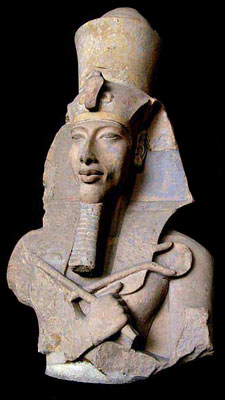Part of the Casswiki article series History

Akhenaten (Amenhotep IV) is the most controversial figure of ancient Egyptian history. He was a pharaoh of the 18th dynasty, living around 1500 BCE. He was married to Nefertiti and preceded the ill-fated boy-king Tutankamon. Akhenaten and Nefertiti had 6 daughters but four of them died before adulthood. Their role in the later stages of the royal family is disputed.
Akhenaten is best-known for his religious revolution, declaring a monotheistic state religion worshiping Aten, the sun god symbolized by the solar disc. For the period of Akhenaten’s reign, the polytheistic Egyption religion, with prevalent worship of Amen (Amun) was displaced but became prevalent again after Akhenaten’s death.
Akhenaten displaced the capital away from Thebes to a new site along the Nile. This Akhetaten - “horizon of Aten” - has been since excavated and the finds display a radical departure from the generally known rigid, stylized format of Egyptian art. The art of this period is of freer form, more in the natural likeness of the objects depicted, more living and diverse.
Few rulers have been more reviled by generations that came after them. Akhenaten was essentially wiped off the records when the priests of Amun again resumed their control via the puppet Tutankhamon. The extensive archeological material on his time is due principally to the fact of his capital city being abandoned at his death. Also the people did not embrace Akhenaten’s religion and apparently gladly returned to the old ways.
To some, Akhenaten is an inspired visionary ahead of his time, to others a madman, yet to others a genetic aberration. Akhenaten is sometimes depicted with a body with feminine external characteristics, excessively broad hips and long neck. Nefertiti is also depicted with an unusually high, vertically stretched head.
The channeled source Ra names Akhenaten as one of its former channels. Ra notes that the wanderer Akhenaten had little experience of Earth and generally received lip service only and could affect no lasting change, good as his intentions may have been.
The FOTCM speculates that the period of Akhenaten was a turning point and that Nefertiti was a central figure in bringing this about. According to some, she was a foreign queen, yet according to others a relative of Akhenaten. It seems that she was one among several probable alien hybrids carrying a genetic tweak giving them the unusual skull shape and cranial volume. The practice of head bandaging in some African tribes may be an imitation of this form. The story of Nefertiti is linked to that of Sarah, wife of Abraham.
Further readings
See also
- Nefertiti
- Tutankhamon
- Egypt
